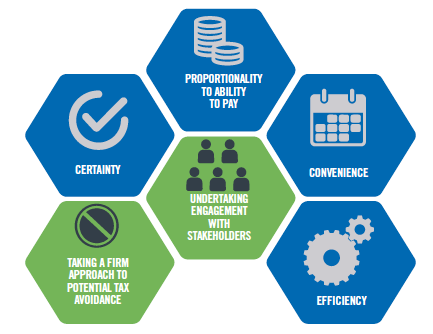The role of income tax in Scotland's budget
A discussion paper that aims to provide useful background to help inform the debate on future use of the income tax powers devolved to the Scottish Parliament.
1 Introduction
Every country in the world faces a debate about the level of public service provision and how public services are funded. The discussion over the appropriate balance between funding public services through taxation as part of a social contract and leaving individuals to make their own spending decisions is centuries old and will no doubt continue.
In the present context of austerity imposed by the UK Government, the uncertainty and economic impact of Brexit and the legitimate expectation from the public of high quality service provision, we believe there are four key tests that any income tax decision must meet.
- Income tax policy should help maintain and promote the level of public services which people in Scotland expect
- The lowest earning taxpayers should not see their taxes increase
- Any tax changes should make the tax system more progressive and reduce inequality
- The changes we make along with our decisions on spending should support the economy.
We must also keep in mind Adam Smith’s principles which underpin the Scottish approach to taxation:
Certainty: Certainty is important for households and businesses alike to ensure that financial decisions can be taken from an informed position on the path of future tax policy.
Convenience: The vast majority of income taxpayers pay their tax through Pay As You Earn ( PAYE), which means there is little or no administrative impact on taxpayers. Decisions made in setting Scottish income tax rates and bands should not needlessly impact on the convenience of the current system.
Efficiency: The collection of Scottish income tax is administered by Her Majesty’s Revenue and Customs ( HMRC), but the cost of any collection activity that is ‘wholly and exclusively’ a consequence of Scottish tax policy falls on the Scottish Government. It is important therefore that policy is designed efficiently to minimise the cost of implementation.
Proportionality: Proportionality to the ability to pay (often referred to as progressivity) in taxation is vital. Everyone benefits from public services and all those who can contribute are expected to do so, but those with the broadest shoulders should bear the greatest burden. In considering this principle we also recognise that inequality damages not only the lives of the poorest in our society but also our economy.
As well as Adam Smith’s founding principles, the Scottish Government’s approach to tax is based on a firm approach to tax avoidance, although in the case of income tax avoidance our powers are more limited as this is the responsibility of the UK Government through HMRC; and a commitment to engagement with stakeholders. Transparency is key to effective engagement - it is vital that everyone understands what their money is spent on. As members of the Open Government Partnership ( OGP), Scotland has committed to increasing financial transparency and this discussion paper supports our commitment within the 2017 OGP National Action Plan.
The Scottish approach to taxation

1.1 Outline of this paper
This paper aims to provide useful background to help inform the debate on the future use of our income tax powers. Chapters 1 to 3 cover matters such as the extent of our income tax powers, how the Scottish Government’s final budget is set, the current make-up of income taxpayers in Scotland, the interaction with reserved areas of policy making and some international comparisons.
Chapter 4 explains what our taxes pay for and the choices available to us. We then set out the tests against which the Scottish Government believes any tax change should be judged. There is unlikely to be unanimity on the relative importance of these tests, but we believe that they are important to guide the discussion and our decisions.
Chapter 5 sets out the income tax proposals that the parties represented in the Scottish Parliament had in their 2016 manifestos and provides detailed analysis of these proposals. We also provide some simple tools which can be used to broadly assess the change in revenue arising from income tax proposals not included in this paper.
We then apply our policy tests to the parties’ proposals in Chapter 6. Following on from this in Chapter 7 we provide a range of possible alternative income tax approaches.
These alternatives do not represent fixed proposals but are included as a starting point for discussion. We also apply the four policy tests to those illustrative approaches to encourage a more open debate on how income tax powers can be used.
The analysis in Chapter 5 of how much parties’ policy proposals would raise in revenue and their impact as well as the analysis in Chapter 7 of alternative approaches that could be adopted have been undertaken by the Scottish Government’s Office of the Chief Economic Adviser and approved by the Scottish Government’s Chief Economist.
Final revenue projections for the Scottish budget will be provided by the Scottish Fiscal Commission.
Contact
There is a problem
Thanks for your feedback